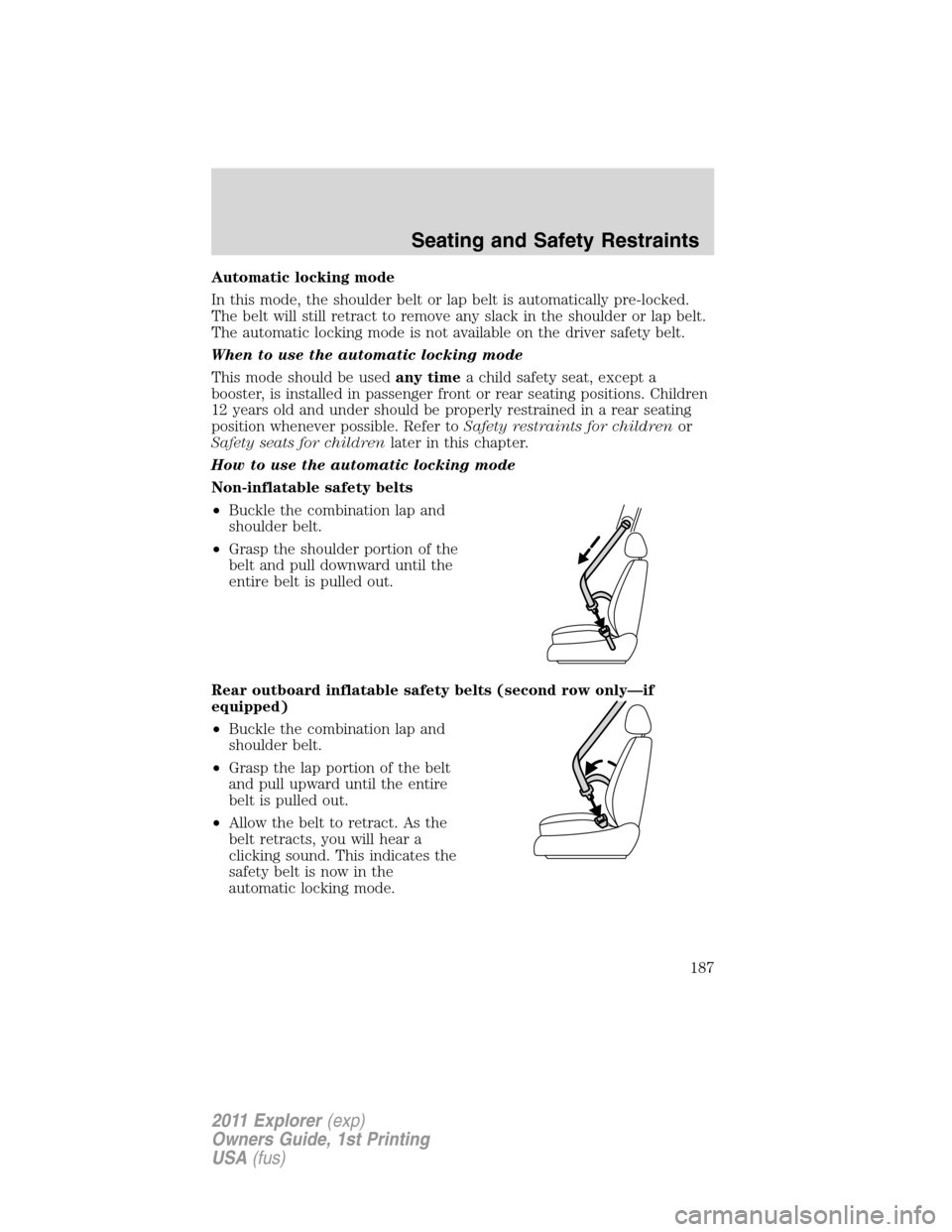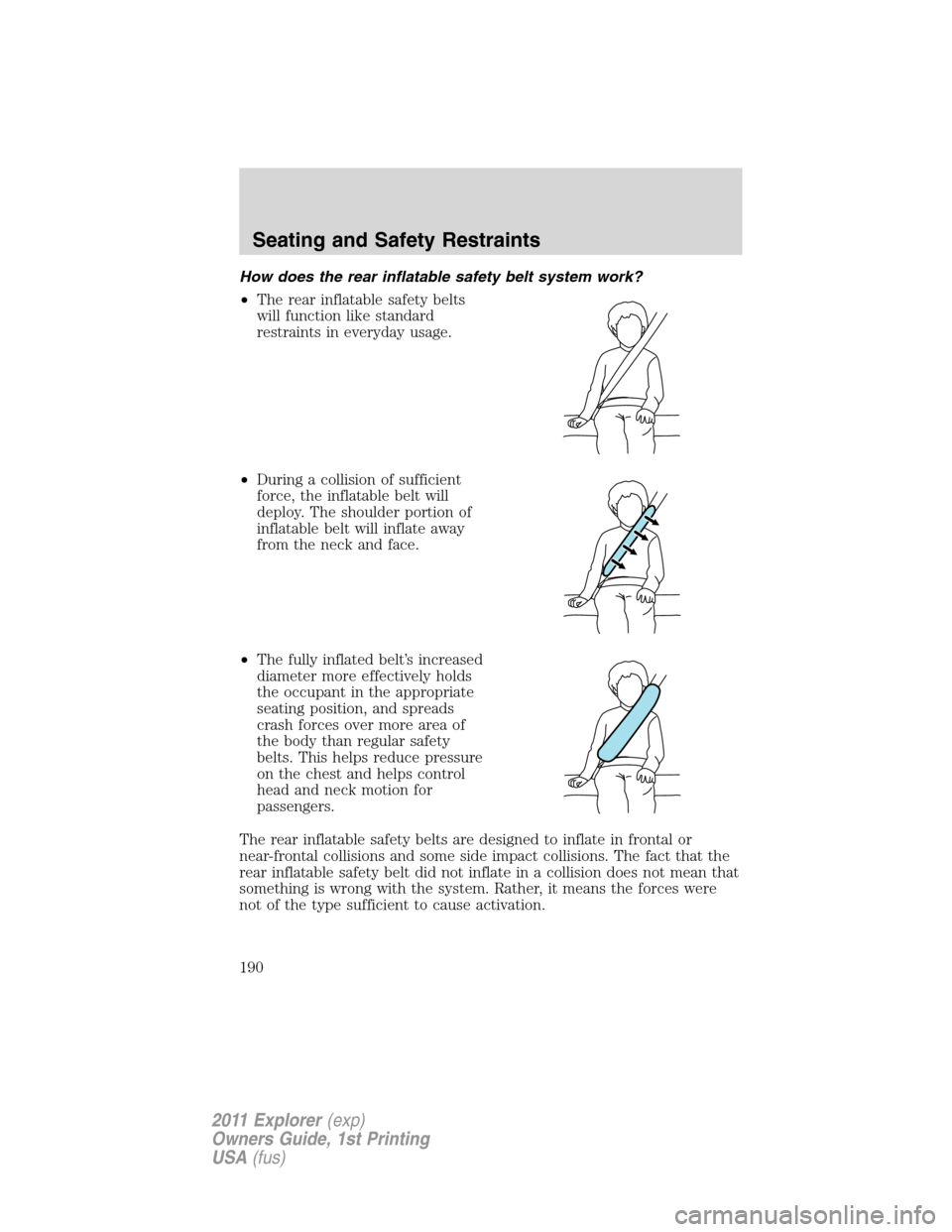Page 184 of 449

Front safety belt pretensioners
The safety belt pretensioners at the front outboard seating positions are
designed to tighten the safety belts firmly against the occupant’s body
during frontal collisions, and in side collisions and rollovers. This helps
increase the effectiveness of the safety belts. In frontal collisions, the
safety belt pretensioners can be activated alone or, if the collision is of
sufficient severity, together with the front airbags.
Front safety belt energy management retractors
The front outboard safety belt energy management retractors allow
webbing to be pulled out of the retractor in a gradual and controlled
manner in response to the occupant’s forward momentum. This helps
reduce the risk of force-related injuries to the occupant’s chest by
limiting the load on the occupant. Refer toEnergy management
feature- front outboardsection in this chapter.
Determining if the Personal Safety System is operational
The Personal Safety System uses a warning light in the instrument
cluster or a back-up tone to indicate the condition of the system. Refer
to theWarning lights and chimessection in theInstrument Cluster
chapter. Routine maintenance of the Personal Safety System is not
required.
The Restraints Control Module (RCM) monitors its own internal circuits
and the circuits for the airbag supplemental restraints, crash sensor(s),
safety belt pretensioners, front safety belt buckle sensors, rear outboard
inflatable belt (if equipped), driver seat position sensor, and front
passenger sensing system. In addition, the RCM also monitors the
restraints warning light in the instrument cluster. A difficulty with the
system is indicated by one or more of the following.
•The warning light will either flash or stay lit.
•The warning light will not illuminate immediately after ignition is
turned on.
•A series of five beeps will be heard. The tone pattern will repeat
periodically until the problem and warning light are repaired.
If any of these things happen, even intermittently, have the Personal
Safety System serviced at an authorized dealer immediately. Unless
serviced, the system may not function properly in the event of a
collision.
Seating and Safety Restraints
183
2011 Explorer(exp)
Owners Guide, 1st Printing
USA(fus)
Page 185 of 449

SAFETY BELT SYSTEM
Safety belt precautions
WARNING:Always drive and ride with your seatback upright
and the lap belt snug and low across the hips.
WARNING:To reduce the risk of injury, make sure children sit
where they can be properly restrained.
WARNING:Never let a passenger hold a child on his or her lap
while the vehicle is moving. The passenger cannot protect the
child from injury in a collision.
WARNING:All occupants of the vehicle, including the driver,
should always properly wear their safety belts, even when an air
bag supplemental restraint system (SRS) is provided.
WARNING:It is extremely dangerous to ride in a cargo area,
inside or outside of a vehicle. In a collision, people riding in
these areas are more likely to be seriously injured or killed. Do not
allow people to ride in any area of your vehicle that is not equipped
with seats and safety belts. Be sure everyone in your vehicle is in a
seat and using a safety belt properly.
WARNING:In a rollover crash, an unbelted person is
significantly more likely to die than a person wearing a seat belt.
WARNING:Each seating position in your vehicle has a specific
safety belt assembly which is made up of one buckle and one
tongue that are designed to be used as a pair. 1) Use the shoulder belt
on the outside shoulder only. Never wear the shoulder belt under the
arm. 2) Never swing the safety belt around your neck over the inside
shoulder. 3) Never use a single belt for more than one person.
WARNING:When possible, all children 12 years old and under
should be properly restrained in a rear seating position.
Seating and Safety Restraints
184
2011 Explorer(exp)
Owners Guide, 1st Printing
USA(fus)
Page 186 of 449
WARNING:Front and rear seat occupants, including pregnant
women, should wear safety belts for optimum protection in an
accident.
Combination lap and shoulder belts (standard belts shown, 2nd
row inflatable belts similar-if equipped)
1. Insert the belt tongue into the
proper buckle (the buckle closest to
the direction the tongue is coming
from) until you hear a snap and feel
it latch. Make sure the tongue is
securely fastened in the buckle.
2. To unfasten, press the release
button and remove the tongue from
the buckle.
Seating and Safety Restraints
185
2011 Explorer(exp)
Owners Guide, 1st Printing
USA(fus)
Page 187 of 449

Restraint of pregnant women
WARNING:Always ride and drive with your seatback upright
and the safety belt properly fastened. The lap portion of the
safety belt should fit snug and be positioned low across the hips. The
shoulder portion of the safety belt should be positioned across the
chest. Pregnant women should also follow this practice. See figure
below.
Pregnant women should always
wear their safety belt. The lap belt
portion of a combination lap and
shoulder belt should be positioned
low across the hips below the belly
and worn as tight as comfort will
allow. The shoulder belt should be
positioned to cross the middle of
the shoulder and the center of the
chest.
Safety belt locking modes
All safety restraints in the vehicle are combination lap and shoulder
belts. The driver safety belt has the first locking mode and the front
outboard passenger and rear seat safety belts have both types of locking
modes described as follows:
Vehicle sensitive mode
This is the normal retractor mode, which allows free shoulder or lap belt
length adjustment to your movements and locking in response to vehicle
movement. For example, if the driver brakes suddenly or turns a corner
sharply, or the vehicle receives an impact of approximately 5 mph
(8 km/h) or more, the combination safety belts will lock to help reduce
forward movement of the driver and passengers.
In addition, the retractor(s) is designed to lock if the webbing is pulled
out too quickly. If this occurs, let the belt retract slightly and pull
webbing out again in a slow and controlled manner.
Seating and Safety Restraints
186
2011 Explorer(exp)
Owners Guide, 1st Printing
USA(fus)
Page 188 of 449

Automatic locking mode
In this mode, the shoulder belt or lap belt is automatically pre-locked.
The belt will still retract to remove any slack in the shoulder or lap belt.
The automatic locking mode is not available on the driver safety belt.
When to use the automatic locking mode
This mode should be usedany timea child safety seat, except a
booster, is installed in passenger front or rear seating positions. Children
12 years old and under should be properly restrained in a rear seating
position whenever possible. Refer toSafety restraints for childrenor
Safety seats for childrenlater in this chapter.
How to use the automatic locking mode
Non-inflatable safety belts
•Buckle the combination lap and
shoulder belt.
•Grasp the shoulder portion of the
belt and pull downward until the
entire belt is pulled out.
Rear outboard inflatable safety belts (second row only—if
equipped)
•Buckle the combination lap and
shoulder belt.
•Grasp the lap portion of the belt
and pull upward until the entire
belt is pulled out.
•Allow the belt to retract. As the
belt retracts, you will hear a
clicking sound. This indicates the
safety belt is now in the
automatic locking mode.
Seating and Safety Restraints
187
2011 Explorer(exp)
Owners Guide, 1st Printing
USA(fus)
Page 189 of 449
How to disengage the automatic locking mode
WARNING:After any vehicle collision, the safety belt system at
all passenger seating positions must be checked by an authorized
dealer to verify that the “automatic locking retractor” feature for child
seats is still functioning properly. In addition, all safety belts should be
checked for proper function.
WARNING:BELT AND RETRACTOR ASSEMBLY MUST BE
REPLACED if the safety belt assembly “automatic locking
retractor” feature or any other safety belt function is not operating
properly when checked by an authorized dealer. Failure to replace the
belt and retractor assembly could increase the risk of injury in
collisions.
Disconnect the combination lap/shoulder belt and allow it to retract
completely to disengage the automatic locking mode and activate the
vehicle sensitive (emergency) locking mode.
Seating and Safety Restraints
188
2011 Explorer(exp)
Owners Guide, 1st Printing
USA(fus)
Page 190 of 449
Rear Inflatable Safety Belt (if equipped)
The rear inflatable safety belts are
fitted in the shoulder safety belts of
the second-row outboard seating
positions.
Note:The rear inflatable safety
belts are compatible with infant and
child safety car seats and belt
positioning booster seats.
The rear inflatable safety belt consists of the following:
•An inflatable bag located in the shoulder safety belt webbing.
•Lap safety belt webbing with automatic locking mode.
•Seat mounted buckles with gas generators concealed under the seat
cushions.
•The same warning light, electronic control and diagnostic unit as used
for the safety belts.
•Impact sensors located in various parts of the vehicle.
WARNING:Do not attempt to service, repair, or modify the rear
inflatable safety belt.
Seating and Safety Restraints
189
2011 Explorer(exp)
Owners Guide, 1st Printing
USA(fus)
Page 191 of 449

How does the rear inflatable safety belt system work?
•The rear inflatable safety belts
will function like standard
restraints in everyday usage.
•During a collision of sufficient
force, the inflatable belt will
deploy. The shoulder portion of
inflatable belt will inflate away
from the neck and face.
•The fully inflated belt’s increased
diameter more effectively holds
the occupant in the appropriate
seating position, and spreads
crash forces over more area of
the body than regular safety
belts. This helps reduce pressure
on the chest and helps control
head and neck motion for
passengers.
The rear inflatable safety belts are designed to inflate in frontal or
near-frontal collisions and some side impact collisions. The fact that the
rear inflatable safety belt did not inflate in a collision does not mean that
something is wrong with the system. Rather, it means the forces were
not of the type sufficient to cause activation.
Seating and Safety Restraints
190
2011 Explorer(exp)
Owners Guide, 1st Printing
USA(fus)